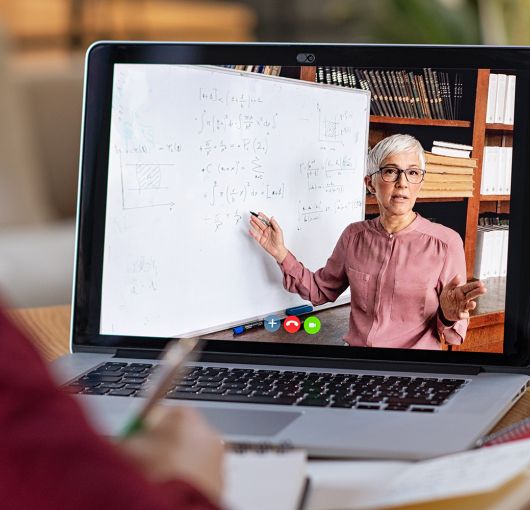Engaging Students in a Virtual Environment

Teaching Presence in an Online Environment
Digital Equivalents to Face-to-Face Interactions
Turn a Virtual Classroom into a Community
Social Responsibility in Today's Online Classroom
Explore Diversity and Inclusion in the Digital World
Current research is making notable connections between underprepared students and mindset, motivation, and the soft skills.
Students with a fixed mindset conclude that aptitude is intrinsic. They construe failure as the lack of fundamental capacity.
Students with a growth mindset trust that they can achieve any skill if they invest sufficient effort.
How does this effect student success?
What strategies can we use in the digital classroom to implement growth mindsets?
Maslow’s hierarchy indicates that basic survival needs must be met before we can think about self-growth. In some cases, the extensive needs of our SUNY Empire students may call for utilizing resources in our Office of Learning Support:
After survival needs are addressed, we may cultivate habits in our virtual classroom with the intent supporting a growth mindset. A few suggestions:
- Embed the idea of mindset into your course announcements and discussions.
- Use the icebreaker discussion to ask “What does it take to be successful in a course?,” and ask classmates to comment.
- Embed the habits you are looking for, such as persistence or creativity, in your assignments, activities and rubrics.
- Consider the idea of productive struggle in your virtual learning environment; failure can be okay if we’re learning from it.
Students prefer when online instructors incorporate interactive elements and opportunities for communication into the virtual classroom. Research suggests that student engagement increases when faculty relate course activities to students' major field of study or life experiences.
Recognize that there is no switch we can flip to change our students' mindsets, but as instructors we can strive to be more flexible and stretch ourselves to stand outside our comfort zone just a little bit. A positive attitude accompanied by hard work is a game changer. In addition to learning our curriculum, our students can learn to become successful.
When we believe, our students believe.
Teaching Presence in an Online Environment

Teaching presence, in the online environment begins with design and organization of learning outcomes, learning activities, and content before the course commences. Teaching Presence continues during the delivery and teaching of the course, as the instructor facilitates discourse and provides direct instruction when required (Anderson, et al, 2001). Teaching presence, a driving force behind social and cognitive processes, is recognized as a key important factor in Higher Ed standards, Federal Regulations, and our accrediting body, Middle States Accreditation.
Direct Instruction, a key indicator of teaching presence is specifically noted in Federal Regulations, which states that distance education must include direct faculty instruction to support regular and substantive interaction between student and instructor, synchronously or asynchronously on a regular and consistent basis each week
What does teaching presence mean for student success at SUNY Empire Online?
Regularly engaging in the course and with students each week of the term, enthusiastically motivating students to stay on task, and offering guidance and support, clarification, and validation of their understanding will enhance the probability of student success in your course. It is what you and the student bring the "the table" that will add value or limitation to success.
Engaging Students Using the Announcement Feature
The Announcement feature does not allow you to have a dialogue with students, it is not an interactive forum, however, it is a useful tool to encourage student engagement by providing them with relevant, clear, meaningful information, resources, observations, etc, to support students to stay on task, engage with the material and activities, and encourage self-directed learning. If you choose to post images or links to videos or audio, they must meet accessibility standards.
In Preparing your Online Classroom, we discussed how to create an inviting welcome announcement at the beginning of the term. Announcements should continue throughout the term to:
- Build rapport
- Create excitement
- Establish credibility and set expectations
- Keep students on task to complete learning activities
- Generate enthusiasm for module content
- Supplement and clarify course content
- Draw upon subject matter expertise, current events, class observations to provide guidance and insight
- Create habits to establish a growth mindset
Digital Equivalents to Face-to-Face Interactions
The learning of content doesn't change in a digital vs face-to-face environment, but the delivery method does. Almost every activity performed in a traditional classroom has a virtual equivalent.
|
Face-to-face classroom |
Online classroom |
|---|---|
|
Lectures |
|
|
Learning resources & handouts |
|
|
Teacher-to-student communication |
|
|
Student-to-student communication |
|
|
Group work |
|
|
Office hours |
|
|
Assignments & assessments |
|
|
Student presentations |
|
|
Scheduling |
|
Turn a Virtual Classroom into a Community
Small groups can prompt students to engage with each other more effectively and actively.
Group assignments are too often met with resistance from students. Instructors often here “I took an online class so I wouldn’t have to interact with other people.” As our world becomes increasingly digital, we need to consider how to turn a virtual classroom into a community.
Using Affinity Groups to Promote a Virtual Community of Learners
At the beginning of your course, have students participate in the icebreaker discussion by sharing their educational goals, hobbies and interests, as well as something unique about them. You then have the information needed to group them based on common interests. Alternatively, ask students to self-enroll in groups of their choice categorized by common activities outside the classroom, for example:
- Chronic Binge Watchers
- Proud Parents
- Obsessive Gamers
- Foodie Fanatics
It is advisable to cap the groups to a small participant list and create more groups than necessary as you won't know exactly where students will be drawn. Finally, so that no student is left behind, create a "None of the above" group, as an additional option to find a common bond.
This may seem like a small distinction from randomly assigning groups, but finding common ground helps students engage with each other more enthusiastically and effectively.
Social Responsibility in Today's Online Classroom

As educators, we turn to research to help guide our behavior and thinking. Social responsibility helps us be thoughtful about our actions, particularly our actions in relation to our students. Listed below are suggestions for socially responsible approaches to engaging with learners.
Multicultural:
Knowledge about different cultural identities / sensitive toward cultural differences
Example of how to engage: Present a set of different choices someone could make during a current situation. For each choice, discuss how a person’s perspective or prior experiences might influence their decision to make a specific choice.
Ethical:
Knowledge and awareness of ethical standards and issues / applies ethical reasoning and standards to make decisions
Example of how to engage: Discuss how a person’s values can influence their decision to make a specific choice.
Civic:
Informed and active at the local, national, or global level / understands and acts on issues of local, national, or global significance.
Example of how to engage: Have learners explore the roles that the local, state, and/or federal government play in current events. Learners could also discuss strengths and weaknesses for having a certain level of government managing situations.
Environmental:
Knowledgeable about current issues of environmental significance / concerned about the wellbeing of the planet / engages in sustainable behaviors.
Have learners explore human responses to global crisises and how this could impact environmental and sustainability endeavors.
By taking time to teach socially responsible thinking and decision-making, you’re also helping your students develop a life skill that will help them navigate difficult situations in the future, whether daily decisions about climate change or even what career path to take. It is also a skill that is considered to be important for employees to demonstrate. 81% of employers rated “ethical judgment and decision-making” as very important in hiring decisions, but only 30% thought recent college graduates were well prepared in this area.
Explore Diversity and Inclusion in the Digital World

Curricular content, pedagogy and accessibility impact students learning, motivation and satisfaction in a course.
In our increasingly digital environment, exploring diversity can guide students to foster a sense of compassion for others. Allowing students to feel unique while still being part of the group helps them prepare for the twenty-first century workplace.
At SUNY Empire Online, we are committed to ensuring an inclusive environment for all of our students. How can we take current research and utilize it to deliver a course that meets these needs?
A profoundly critical aspect of any online course is communication.
One of the most prevalent differences between digital and face-to-face courses is how students and instructors interact in the learning environment. Not only does the online classroom remove the physical, synchronous presence from the learning community, it regularly shifts the bulk of communications to written exchanges.
Emphasis on the written word can create potential issues related to the interpretation of content. Students, particularly English as a Second Language (ESL) students, may look for hidden messages in feedback or decipher feedback differently. Consider the potential misinterpretation of written forums or feedback and the impact on student performance and attitude. Be clear and thorough. It may be useful to build samples of frequent errors with detailed notes to share with students.
Keep in mind that students do not necessarily have to be English language learners for their culture to influence their interpretation or understanding of the meaning of written text within a course. Culture can impact the dynamics of the exchanges as well. Cultural norms, the common beliefs, expectations, and practices of a society, may impact how and when students respond to questions. For example, students from Western cultures may be more apt to view the instructor as a facilitator, rather than non-Western students. In some cultures, the instructor is viewed authoritative in nature.
Your work as an instructor sets the tone for a safe space in the classroom where students can share their experiences and perspectives.
- Strive to understand your students.
- Utilize varied teaching strategies and materials.
- Structure the course to provide equal opportunities to all students.
- Celebrate diversity.
- Encourage differing perspectives.
- Ask students to share their views and substantiate why they feel/think that way
- Seek to include diverse learning materials.
After focusing on engaging students, explore the next step: Supporting Student Challenges

This work is licensed under a Creative Commons Attribution-NonCommercial-ShareAlike 4.0 International License.